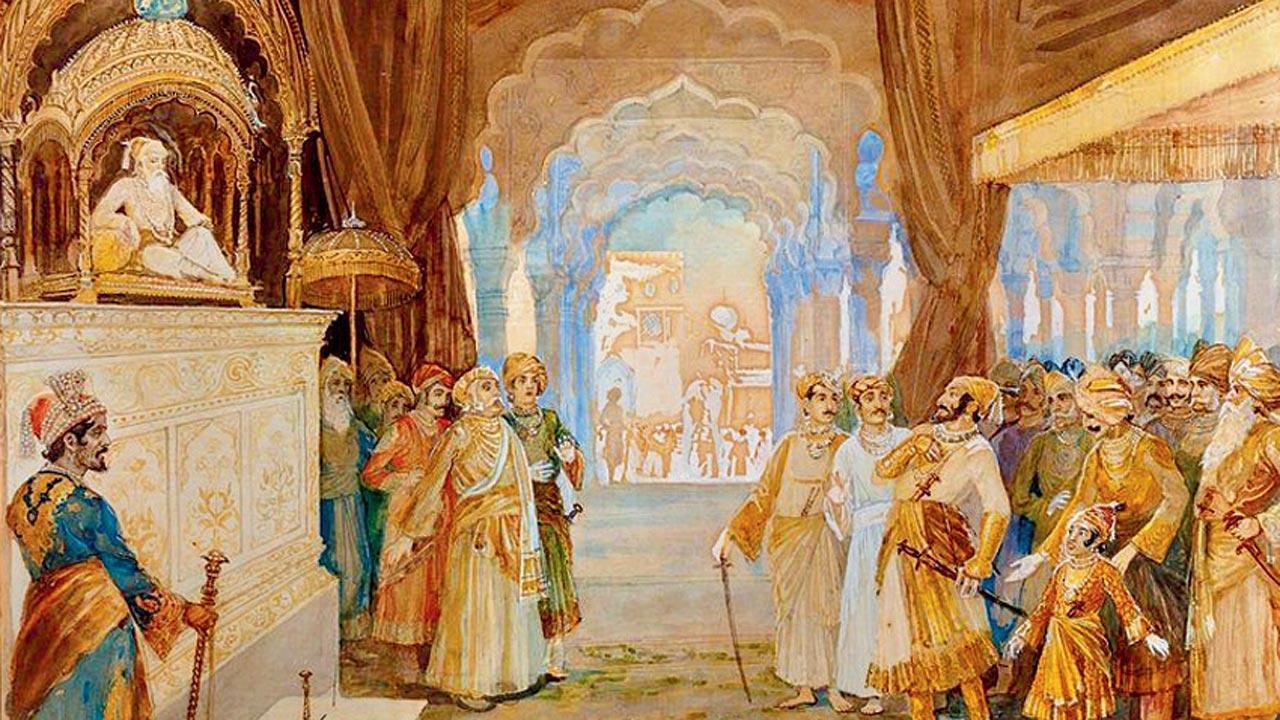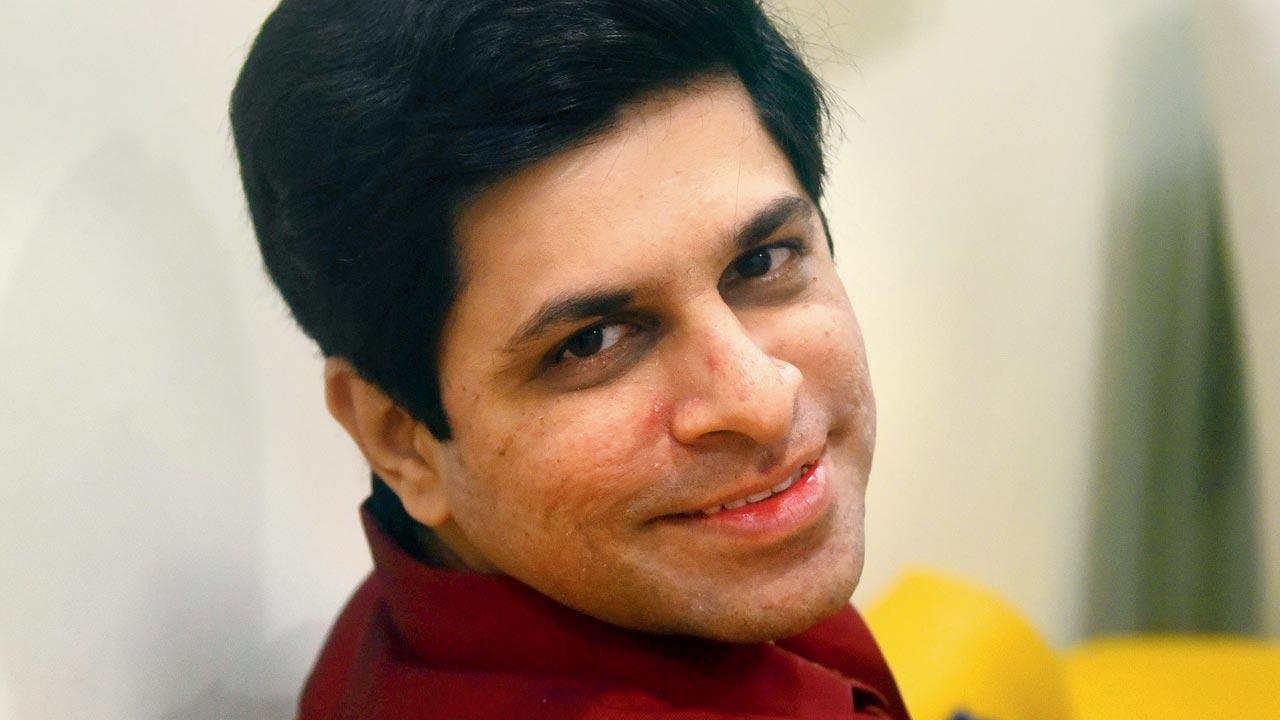A new biography on the 17th century Maratha warrior king dips into Marathi accounts by eyewitness chroniclers, previously ignored by historians, to create the portrait of a man whose rebellious streak continues to influence Maharashtra politics

threshold of my Court”. But when he made him stand in a line meant for paanch hazari officials which was the third row of ranking officials, Shivaji got offended and stormed out. He was placed under house arrest. Pic/MV Dhurandhar; Wikimedia Commons
Journalist Vaibhav Purandare has been invested in Shivaji Bhosle I, popularly known as Chhatrapati Shivaji, since he was a school student. He recalls writing down every bit of information that he could find on the 17th century Maratha warrior. These stories, he says, never left him. When he “seriously” began researching Shivaji seven years ago, Purandare’s effort was to create a comprehensive portrait of the leader, which he felt has eluded most historians. “...A vast variety of Marathi sources have been completely disregarded by people writing in English about Chhatrapati Shivaji Maharaj,” says Mumbai-based Purandare in an interview to mid-day. He specifically highlights the accounts of two chroniclers, both Shivaji’s contemporaries—Parmanand, who authored Shivabharat, and the writer of Sabhasad Bakha, Krishnaji Anant Sabhasad. “Parmanand was an associate of Shivaji, and witnessed some of the key events in his life. In fact, he accompanied Shivaji to many of the battles that he was fighting. In some of his descriptions, you will even find precise details of what Shivaji was wearing on a particular occasion,” he says. “Both Parmanand and Sabhasad’s accounts are important, because they were personally present when events were unfolding around Shivaji.”
Purandare says that the oversight was a result of the language barrier. The two chroniclers wrote in Marathi, but historians like Jadunath Sarkar and Dennis Kincaid, whose works on Shivaji continue to be widely read, researched and referenced, could not read Marathi. “Of course, you cannot arbitrarily dismiss their works [on these grounds]. That would be a very unfair approach. But it does explain why these historians got fundamental details wrong... like his birth year [Shivaji was born on February 19, 1630],” he says, arguing, “It’s important to restore the primacy of these narratives, because both Parmanand and Sabhasad were eyewitnesses. Does this mean we have to swallow every word they said? Not at all. We have to weigh their evidence against other contemporary evidence.”
 Senior journalist and author Vaibhav Purandare says he was fascinated by anecdotes around Shivaji’s life ever since he was a school student
Senior journalist and author Vaibhav Purandare says he was fascinated by anecdotes around Shivaji’s life ever since he was a school student
Purandare’s just-released biography of the warrior king, Shivaji: India’s Great Warrior King (Juggernaut Books) digs deep into varied accounts by scholars and biographers alike, to tell the tale of a self-made military hero who crowned himself king, igniting Maratha pride and consciousness.
Shivaji was born to Jijabai and Shahaji Bhosle, who like his father Maloji carried forward the military tradition of the family, becoming one of Ahmednagar Sultanate Nizam Shahi’s leading chieftains. Shivaji wasn’t one to toe the line. His rebel streak notwithstanding, at an early age, Shivaji was convinced that the system around him was “unjust and exploitative”. “He realised that it was arbitrary in its administrative processes and in delivering justice,” says Purandare, adding, “The Adil Shahi state was slowly becoming fanatical in nature. There are written directives by the then ruler ensuring that no Hindu gets a rank above a certain level as they were ‘non-believers’, and that their festivals are not celebrated in a grand way. The attempt was to undermine people’s belief in their own faith, kill their self-confidence and obliterate their cultural identity. That is something that Shivaji instinctively revolted against.” But he revolted in stages, never rushing into battle and sacrificing himself, because he was also aware of the strengths and weakness of the state he was building. “This is why he never fought pitched-battles in open fields. His strength was in the mountains and hills... this is how he systematically captured forts,” says Purandare alluding to Shivaji’s guerrilla warfare tactics. Incidentally, it was Malik Ambar, the Ethiopian regent of the Nizam Shahi state whom Shivaji’s grandfather Maloji served, who was “the first to use bargir-giri or guerrilla warfare to deadly effect with the help of the terrain-knowing Marathas”.
 Purandare says Shivaji’s strength was negotiating the mountains. His capturing of the Raigad fort from the More’s of Jawwali is important because it helped Shivaji challenge the Adil Shahi dynasty
Purandare says Shivaji’s strength was negotiating the mountains. His capturing of the Raigad fort from the More’s of Jawwali is important because it helped Shivaji challenge the Adil Shahi dynasty
According to Purandare, what Shivaji had was a vision that was quite ahead of its time. “An early example of this vision is the capital punishment he handed out to a village head accused of sexual assault,” he says. The case refers to an ordinary village woman who was abused by a patil in Khede Bare near Pune, which was part of Shivaji’s jagir. “Once he determined that the complaint was accurate, he handed out capital punishment to the village head immediately. Remember, Shivaji is only 16 at this time, and the patil represents hierarchy, establishment, and oppression. Despite this, Shivaji ensures justice is meted out. That changes the mood of the entire village. It also fosters a belief within the village population that their men and women are likely to have a future if they follow what the teenager is doing.”
While much is written about Shivaji’s relationship with his mother Jijabai, whom he loved deeply, very little is known about the dynamics between Shivaji and his father, Shahaji. “It was a fact that Shivaji, who lived in the Sahyadris, was a self-made man, and it was also a fact that Shahaji who was in Bangalore continued to serve the Adil Shahi state even after Shivaji had rebelled. Their bond was very strong despite the distance—Shahaji not only gave him his jagirs in Pune and beyond, he didn’t strike down the reforms his son was trying to implement. When Shivaji started his revolt against Bijapur by conquering four forts in the vicinity of Pune, Shahaji, accused of being responsible for his son’s activities, was arrested by his rivals in the Adil Shahi court. Even then, he didn’t condemn his son. Somewhere there seems to be an implicit approval [from Shahaji’s side] without any active involvement in his son’s political enterprise,” feels Purandare.
 The Indian Navy has switched to a new ensign. One of the design elements honours Shivaji Maharaj
The Indian Navy has switched to a new ensign. One of the design elements honours Shivaji Maharaj
When discussing Shivaji one cannot not mention his arch nemesis and Mughal emperor Muhi al-Din Muhammad or Aurangzeb, who ruled from 1658 to 1707. Purandare’s book peels through the layers of their controversial political relationship, which escalated after Shivaji attacked Aurangzeb’s maternal uncle and distinguished Mughal general Shayista Khan. “The responses to Shivaji were quite interesting right from the beginning of his career... initially everyone, including the Bijapur forces, dismissed him. It was only when he captured the valleys of Jaawali near Wai at the age of 26 that he created a sense of alarm. That’s when Bijapur woke up and sent a powerful leader like Afzal Khan to eliminate him [Afzal was killed by Shivaji].” But Aurangzeb, says Purandare, stood out among all these rulers. “He never underestimated Shivaji. In the early 1640s, when Shivaji was still in his teens, Aurangzeb was the governor of the Deccan, so he knew the region well. From the very start, he was convinced that Shivaji was a threat, despite the small size of his territory, because Aurangzeb was aware of the vitality of his enterprise. He knew he had to crush him, if he had to conquer the Deccan.”
When Aurangzeb laid siege on Shivaji’s territory, recapturing most of his forts, the Maratha warrior momentarily acquiesced and agreed to fight on the side of his sworn rival. Still distrusting of the Mughal warlord, he visited him in Agra with his entourage, only to be humiliated again. His outburst in the court and subsequent house arrest, set the stage for his miraculous, and now legendary, escape in a wicker basket. Purandare says that Shivaji is unique in the early modern history of India because “he challenged the Mughal empire when it was at the height of its glory under Aurangzeb and not just changed the political map of the Deccan ,but of all of India by sowing the seeds of the empire’s eventual fall and destruction.”
That political parties in Maharashtra continue to appropriate Shivaji, who was also the pioneering force behind developing an indigenous naval fleet to counter his enemies and the “firangs”, hardly comes as a surprise to Purandare. “His politics was not discriminatory, which is why Shivaji is universally accepted. The state he went on to create was so big that eventually the Marathas were ruling everywhere. Shivaji gave people immense self-confidence. That explains why everyone wants to claim him—and they will continue to.”
 Subscribe today by clicking the link and stay updated with the latest news!" Click here!
Subscribe today by clicking the link and stay updated with the latest news!" Click here!










